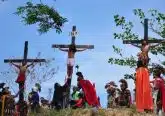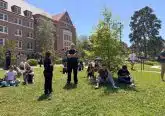Mission dioceses minister to Catholics scattered over great distances

IMAGE: Nancy Wiechec
By Chaz Muth
WASHINGTON (CNS) — Catholic missionaries played a large role in bringing European values and religion to North America in the 18th century.
The role of the Franciscans, Jesuits, Dominicans and other Catholic religious orders was to set up missions that became economic, political and religious centers.
The mission church hasn’t gone away. It’s a vibrant part of the U.S. Catholic fabric. It’s just evolved during the course of the past few centuries.
The primary function of the 21st-century mission church no longer includes proselytizing the indigenous people, but is aimed at bringing Catholicism to populations throughout the land, regardless of the challenges to do so.
Catholics living in most of the territory of the U.S. are actually shepherded by a Catholic home mission diocese.
So, what is a Catholic home mission?
The U.S. Conference of Catholic Bishops defines a home mission as a “diocese or parish that can’t provide the basic pastoral services to Catholics without outside help.”
Those basic pastoral services include Mass, the sacraments, religious education, and ministry training for lay ministers, deacons, religious sisters and priests.
“Most of the mission dioceses, if you look at the map it will tell you that they are very rural, very large usually, do not have the resources that our more urban … dioceses like New York or Los Angeles would have, so we make ends meet with very little,” said Bishop Peter F. Christensen, who heads the Diocese of Boise, Idaho, which is a mission diocese.
“That ‘little’ is subsidized by the work of Catholic Home Missions, which is subsidized by the generosity of our people throughout the country,” added the bishop, who is the former chairman of the U.S. bishops’ Subcommittee on Catholic Home Missions.
The U.S. bishops established the Catholic Home Missions Appeal in 1998. It’s a national collection taken up in parishes throughout the country, usually in April, to help fund the pastoral outreach in the mission dioceses in places such as Alaska, New Mexico, Idaho, the Marshall Islands, Puerto Rico and parts of Texas.
The U.S. Catholic Church has a long history of sending missionaries to serve people in Africa, Asia, Latin America and Oceania, Bishop Christensen said.
Home mission dioceses in the U.S. are in need of the same kind of care, which is why the grants that come from the annual appeal are so vital to Catholics in the mission dioceses, which also include Gallup, New Mexico, and Little Rock, Arkansas, he said.
Salt Lake City, another U.S. mission diocese, consists of 85,000 square miles, which is the entire state of Utah, and some of the Eastern Catholic eparchies, which also are considered Catholic home missions, cover the entire U.S. and consist of millions of square miles.
Bishops, priests, deacons, religious sisters and dedicated lay ministers can put 50,000 miles a year on their cars just to reach the Catholics they are charged with providing pastoral care to, Bishop Christensen told Catholic News Service during an interview in Boise.
The ministry of Father Adrian Vazquez, a priest in his diocese, illustrates the situation. He is charged with the pastoral care of four Catholic communities in eastern Idaho, a parish in St. Anthony and three mission stations located in Rexburg, Driggs and Island Park.
He divides his time between all those locations, driving hundreds of miles a week.
Sometimes the priest relies on the kindness of his parishioners in Driggs and Island Park to put him up for the night, since his residence is at the rectory in far off St. Anthony.
“The travel can be a real challenge, especially in the winter when there is a lot of snow,” said Father Vazquez, a native of Mexico. “My parishioners have to be patient with me sometimes if I’m running behind and we just start when I arrive.”
The U.S. mission church of the 21st century faces some of the same challenges 18th-century missionaries encountered in that the faith remains poorly established in several parts of the country, including the Rocky Mountain states, the South, areas along the Mexican border and in the Pacific islands, Bishop Christensen said.
In 2014, the national Catholic Home Missions Appeal raised more than $9.3 million and gave out more than $9.1 million in grants and donations to fund programs in the mission dioceses, according to the subcommittee’s annual report.
The dioceses received money for programs involving faith formation, cultural diversity, strengthening marriage, repairs to churches, evangelization, prison outreach, as well as priestly and religious vocations.
In recent years, the mission dioceses have seen an increase in religious vocations, which is desperately needed, but that too brings its own set of challenges for financially strapped institutions in those areas.
“To educate a seminarian today costs an average of $37,000,” Bishop Christensen said. “That’s not small change for a diocese that can’t support that.
“There’s a (mission) diocese in Texas that has 23 seminarians,” he said. “Multiply that out by $37,000 and that gets into some pretty amazing figures.”
The permanent diaconate has become an important source of vocations for these dioceses, Bishop Christensen said.
Deacons can provide various pastoral ministries, like preaching, baptizing, witnessing marriages and conducting funeral services, helping alleviate the stress for some priests who are caring for multiple faith communities spread across hundreds of miles.
The Diocese of Juneau, Alaska, has a total of 10 priests who serve a geographic region that is about the size of the state of Florida, said Juneau Bishop Edward J. Burns.
“The communities are small,” Bishop Burns told CNS during an interview in Juneau. “We can have just a handful of people who gather for Mass at the kitchen table, because we don’t have a chapel or church in some of our villages.”
The priests, deacons, religious sisters and lay ministers say it’s important to get into the small communities in the far reaches of these mission dioceses, not only to bring them the sacraments, but to help them prepare for marriage, strengthen their relationships, sometimes cope with poverty, morn the dead and become positive models for their children, he said.
Like the missionaries of the 18th century, Bishop Christensen said much of the work in a mission diocese is evangelization.
When he was first appointed bishop of Juneau in 2009, Bishop Burns learned that 10 percent of the mission diocese’s population was Catholic and 60 percent didn’t identify with any religion.
“I thought to myself, ‘What a wonderful challenge this is going to be,'” he said. “It’s an opportunity for us to engage in the new evangelization, because it’s not like these people have never heard of Jesus Christ, or the Gospel message, or that they’ve never been in contact with the church. It’s just that they choose to be secularists. They have chosen to step aside from their religion or faith.
“For us, it’s a wonderful challenge,” Bishop Burns said, “to awaken in them a relationship with Jesus Christ.”
– – –
Follow Chaz Muth on Twitter: @Chazmaniandevyl.
– – –
Copyright © 2016 Catholic News Service/U.S. Conference of Catholic Bishops. www.catholicnews.com. All rights reserved. Republishing or redistributing of CNS content, including by framing or similar means without prior permission, is prohibited. You may link to stories on our public site. This copy is for your personal, non-commercial use only. To request permission for republishing or redistributing of CNS content, please contact permissions at [email protected].













